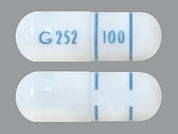Conzip
Tramadol Hcl
What is Conzip used for?
See also Warning section. This medication is used to help relieve severe ongoing pain. Tramadol belongs to a class of drugs known as opioid analgesics. It works in the brain to change how your body feels and responds to pain.
CHEMICAL NAME
DRUG TYPE
Pain/InflammationConzip Prices
Searching for the lowest prices
What does Conzip look like?
View all Conzip Image Information (1)Conzip Frequently Asked Questions
Tramadol has a risk for abuse and addiction, which can lead to overdose and death. Tramadol may also cause severe, possibly fatal, breathing problems. To lower your risk, your doctor should have you take the smallest dose of tramadol that works, and take it for the shortest possible time. See also How to Use section for more information about addiction.
Ask your doctor or pharmacist if you should have medication available to treat opioid overdose (such as naloxone, nalmefene). Teach your family or household members about the signs of an opioid overdose and how to treat it.
The risk for severe breathing problems is higher when you start this medication and after a dose increase, or if you take the wrong dose/strength. Taking this medication with alcohol or other drugs that can cause drowsiness or breathing problems may cause very serious side effects, including death. Also, other medications can affect the removal of tramadol from your body, which may affect how tramadol works. Be sure you know how to take tramadol and what other drugs you should avoid taking with it. See also Drug Interactions section. Get medical help right away if any of these very serious side effects occur: slow/shallow breathing, unusual lightheadedness, severe drowsiness/dizziness, difficulty waking up.
Keep this medicine in a safe place to prevent theft, misuse, or abuse. If someone accidentally swallows this drug, get medical help right away.
Before using this medication, women of childbearing age should talk with their doctor(s) about the risks and benefits. Tell your doctor if you are pregnant or if you plan to become pregnant. During pregnancy, this medication should be used only when clearly needed. It may slightly increase the risk of birth defects if used during the first two months of pregnancy. Also, using it for a long time or in high doses near the expected delivery date may harm the unborn baby. To lessen the risk, take the smallest effective dose for the shortest possible time. Babies born to mothers who use this drug for a long time may develop severe (possibly fatal) withdrawal symptoms. Tell the doctor right away if you notice any symptoms in your newborn baby such as crying that doesn't stop, slow/shallow breathing, irritability, shaking, vomiting, diarrhea, poor feeding, or difficulty gaining weight.
Children younger than 18 years should not use products that contain tramadol. Some children are more sensitive to tramadol and have had very serious (rarely fatal) breathing problems such as slow/shallow breathing (see also Side Effects section). The risk is greater in children who are obese or have breathing problems, or after certain surgeries (including tonsil/adenoid removal). Talk with your doctor or pharmacist about the risks and benefits of this medication.
IMPORTANT: HOW TO USE THIS INFORMATION: This is a summary and does NOT have all possible information about this product. This information does not assure that this product is safe, effective, or appropriate for you. This information is not individual medical advice and does not substitute for the advice of your health care professional. Always ask your health care professional for complete information about this product and your specific health needs.
